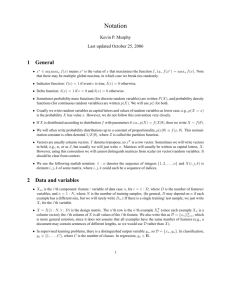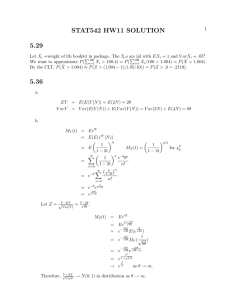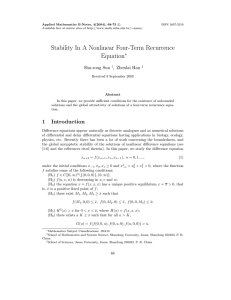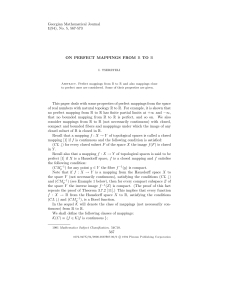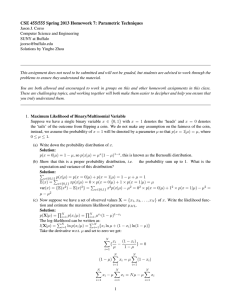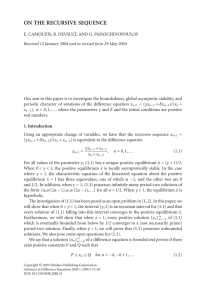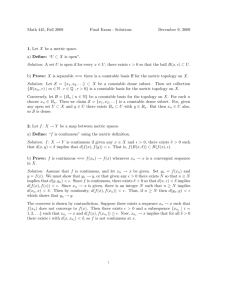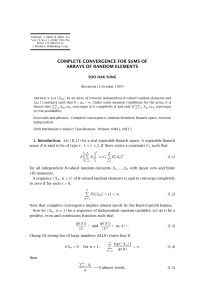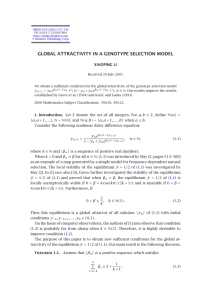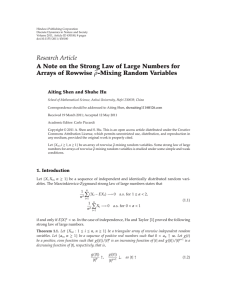Document 10940089
advertisement
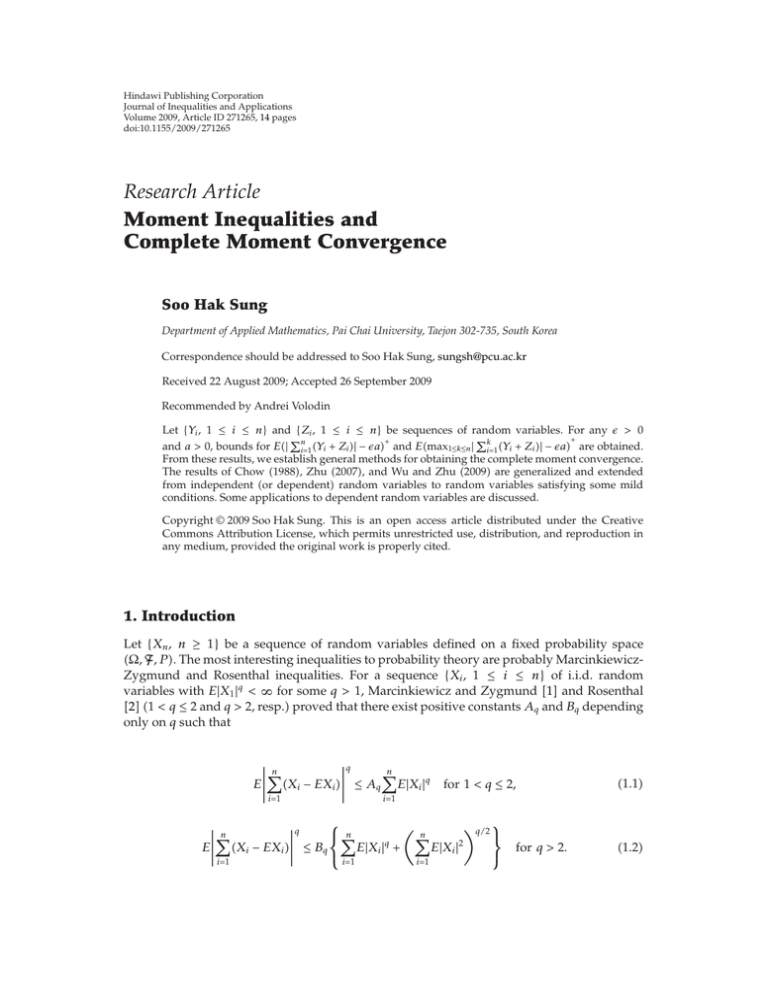
Hindawi Publishing Corporation
Journal of Inequalities and Applications
Volume 2009, Article ID 271265, 14 pages
doi:10.1155/2009/271265
Research Article
Moment Inequalities and
Complete Moment Convergence
Soo Hak Sung
Department of Applied Mathematics, Pai Chai University, Taejon 302-735, South Korea
Correspondence should be addressed to Soo Hak Sung, sungsh@pcu.ac.kr
Received 22 August 2009; Accepted 26 September 2009
Recommended by Andrei Volodin
Let {Yi , 1 ≤ i ≤ n} and {Zi , 1 ≤ i ≤ n} be sequences of random variables. For any > 0
and a > 0, bounds for E| ni1 Yi Zi | − a and Emax1≤k≤n | ki1 Yi Zi | − a are obtained.
From these results, we establish general methods for obtaining the complete moment convergence.
The results of Chow 1988, Zhu 2007, and Wu and Zhu 2009 are generalized and extended
from independent or dependent random variables to random variables satisfying some mild
conditions. Some applications to dependent random variables are discussed.
Copyright q 2009 Soo Hak Sung. This is an open access article distributed under the Creative
Commons Attribution License, which permits unrestricted use, distribution, and reproduction in
any medium, provided the original work is properly cited.
1. Introduction
Let {Xn , n ≥ 1} be a sequence of random variables defined on a fixed probability space
Ω, F, P . The most interesting inequalities to probability theory are probably MarcinkiewiczZygmund and Rosenthal inequalities. For a sequence {Xi , 1 ≤ i ≤ n} of i.i.d. random
variables with E|X1 |q < ∞ for some q > 1, Marcinkiewicz and Zygmund 1 and Rosenthal
2 1 < q ≤ 2 and q > 2, resp. proved that there exist positive constants Aq and Bq depending
only on q such that
q
n
n
E Xi − EXi ≤ Aq E|Xi |q
i1
i1
for 1 < q ≤ 2,
⎧
q
q/2 ⎫
n
n
n
⎨
⎬
E Xi − EXi ≤ Bq
E|Xi |q E|Xi |2
i1
⎩ i1
⎭
i1
for q > 2.
1.1
1.2
2
Journal of Inequalities and Applications
The following Marcinkiewicz-Zygmund and Rosenthal type maximal inequalities are well
known. For a sequence {Xi , 1 ≤ i ≤ n} of i.i.d. random variables with E|X1 |q < ∞ for some
q > 1, there exist positive constants Cq and Dq depending only on q such that
q
k
n
Emax Xi − EXi ≤ Cq E|Xi |q for 1 < q ≤ 2,
1≤k≤n
i1
i1
⎧
q
q/2 ⎫
k
n
n
⎨
⎬
E|Xi |q E|Xi |2
for q > 2.
Emax Xi − EXi ≤ Dq
⎩ i1
⎭
1≤k≤n
i1
i1
1.3
1.4
Note that 1.3 and 1.4 imply 1.1 and 1.2, respectively. The above inequalities
have been obtained for dependent random variables by many authors. Shao 3 proved that
1.3 and 1.4 hold for negatively associated random variables. Asadian et al. 4 proved that
1.1 and 1.2 hold for negatively orthant dependent random variables.
For a sequence of some mixing random variables, 1.4 holds. However, the constant
Dq depends on both q and the sequence of mixing random variables. Shao 5 obtained
1/2 n
2 < ∞.
1.4 for φ-mixing identically distributed random variables satisfying ∞
n1 φ
Shao 6 also obtained 1.4 for ρ-mixing identically distributed random variables satisfying
∞ 2/q n
2 < ∞. Utev and Peligrad 7 obtained 1.4 for ρ∗ -mixing random variables.
n1 ρ
The concept of complete convergence was introduced by Hsu and Robbins 8. A
sequence {Xn , n ≥ 1} of random variables is said to converge completely to the constant
θ if
∞
P |Xn − θ| > < ∞ ∀ > 0.
1.5
n1
In view of the Borel-Cantelli lemma, this implies that Xn → θ almost surely. Therefore the
complete convergence is a very important tool in establishing almost sure convergence of
summation of random variables. Hsu and Robbins 8 proved that the sequence of arithmetic
means of i.i.d. random variables converges completely to the expected value if the variance
of the summands is finite. Erdös 9 proved the converse.
The result of Hsu-Robbins-Erdös has been generalized and extended in several
directions. Baum and Katz 10 proved that if {Xn , n ≥ 1} is a sequence of i.i.d. random
variables with E|X1 | < ∞, E|X1 |pt < ∞ 1 ≤ p < 2, t ≥ 1 is equivalent to
n
t−2
1/p
<∞
n P Xi − EXi > n
i1
n1
∞
∀ > 0.
1.6
Chow 11 generalized the result of Baum and Katz 10 by showing the following complete
moment convergence. If {Xn , n ≥ 1} is a sequence of i.i.d. random variables with E|X1 |pt < ∞
Journal of Inequalities and Applications
3
for some 1 ≤ p < 2 and t > 1, then
∞
t−2−1/p
n
n1
n
1/p
E Xi − EXi − n
<∞
i1
1.7
∀ > 0,
where a max{a, 0}. Note that 1.7 implies 1.6 see Remark 2.6.
Recently, Zhu 12 obtained a complete convergence for ρ∗ -mixing random variables.
Wu and Zhu 13 obtained complete moment convergence results for negatively orthant
dependent random variables.
In this paper, we give general methods for obtaining the complete moment
convergence by using some moment inequalities. From these results, we generalize and
extend the results of Chow 11, Zhu 12, and Wu and Zhu 13 from independent or
dependent random variables to random variables satisfying some conditions similar to
1.1–1.4.
2. Complete Moment Convergence for Random Variables
In this section, we give general methods for obtaining the complete moment convergence
by using some moment inequalities. The first two lemmas are simple inequalities for real
numbers.
Lemma 2.1. For any real numbers a, b, c, the inequality holds
|a b| − |c| ≤ |a| − |c| |b|.
2.1
Proof. The result follows by an elementary calculation.
The following lemma is a slight generalization of Lemma 2.1.
Lemma 2.2. Let {ai , 1 ≤ i ≤ n} and {bi , 1 ≤ i ≤ n} be two sequences of real numbers. Then for any
real number c, the inequality holds
max|ai bi | − |c|
≤ max|ai | − |c| max|bi |.
1≤i≤n
1≤i≤n
2.2
1≤i≤n
Proof. By Lemma 2.1, we obtain
max|ai bi | − |c| ≤ max |ai | − |c| |bi |
max|ai bi | − |c|
1≤i≤n
1≤i≤n
1≤i≤n
≤ max|ai | − |c| max|bi | max|ai | − |c| max|bi |.
2.3
1≤i≤n
1≤i≤n
1≤i≤n
1≤i≤n
The next two lemmas play essential roles in the paper. Lemma 2.3 gives a moment
inequality for the sum of random variables.
4
Journal of Inequalities and Applications
Lemma 2.3. Let {Yi , 1 ≤ i ≤ n} and {Zi , 1 ≤ i ≤ n} be sequences of random variables. Then for any
q > 1, > 0, a > 0,
q
n
n
n
1 1
1
E Yi Zi − a
≤
E Yi E Zi .
q
q−1
i1 i1 i1
q−1 a
2.4
Proof. By Lemma 2.1,
n
n
n
E Yi Zi − a
≤ E Yi − a
E Zi .
i1
i1 i1 2.5
On the other hand, we have by Markov’s inequality that
∞ n
n
E Yi − a
P Yi − a > t dt
i1 i1 0
a ∞ n
n
P Yi > a t dt P Yi > a t dt
i1 i1 0
a
∞ n
n
≤ aP Yi > a P Yi > t dt
i1 a
i1
≤
q
E ni1 Yi q aq−1
2.6
q n
∞1
E Yi dt
i1 a tq
q
n
1
1
1 E
Y
.
i
q q − 1 aq−1 i1 Substituting 2.6 into 2.5, we have the result.
The following lemma gives a moment inequality for the maximum partial sum of
random variables.
Lemma 2.4. Let {Yi , 1 ≤ i ≤ n} and {Zi , 1 ≤ i ≤ n} be sequences of random variables. Then for any
q > 1, > 0, a > 0,
q
k
k
k
1
1
1
E max Yi Zi − a
≤
Emax
Y
Emax
Z
.
i
i
q
q−1 1≤k≤n
q
−
1
1≤k≤n
1≤k≤n
a
i1
i1
i1
2.7
Journal of Inequalities and Applications
5
Proof. By Lemma 2.2,
k
k
k
E max Yi Zi − a
≤ E max Yi − a
Emax Zi .
1≤k≤n
1≤k≤n
1≤k≤n
i1
i1
i1
2.8
The rest of the proof is similar to that of Lemma 2.3 and is omitted.
Now we state and prove one of our main results. The following theorem gives
a general method for obtaining the complete moment convergence for sums of random
variables satisfying 2.9. The condition 2.9 is well known Marcinkiewicz-Zygmund
inequality.
Theorem 2.5. Let {Xni , 1 ≤ i ≤ n, n ≥ 1} be an array of random variables with E|Xni | < ∞ for
1 ≤ i ≤ n, n ≥ 1. Let {an , n ≥ 1} and {bn , n ≥ 1} be sequences of positive real numbers. Suppose
that the following conditions hold.
i For some 1 < q ≤ 2, there exists a positive constant Cq depending only on q such that
q
n
n
q
E
Xni − EXni
≤ Cq EXni
i1
i1
∀n ≥ 1,
2.9
Xni I|Xni | ≤ an an IXni > an − an IXni < −an .
where Xni
ii
iii
∞
n1
∞
n1
−q
bn an
bn a−1
n
n
i1
n
i1
E|Xni |q I|Xni | ≤ an < ∞.
E|Xni |I|Xni | > an < ∞.
Then
n
E Xni − EXni − an
<∞
i1
a
n1 n
∞
bn
∀ > 0.
2.10
Proof. Observe that
q
E|Xni |q I|Xni | ≤ an aqn P |Xni | > an EXni
q−1
≤ E|Xni |q I|Xni | ≤ an an E|Xni |I|Xni | > an ,
E|Xni − an IXni > an Xni an IXni < −an |
EXni − Xni
≤ E|Xni |I|Xni | > an .
2.11
2.12
6
Journal of Inequalities and Applications
Then we have by Lemma 2.3, 2.9, 2.11, and 2.12 that
n
E Xni − EXni − an
i1
a
n1 n
q
∞
n
bn 1
1
≤
E
X − EXni q q − 1 n1 aqn i1 ni
∞
n
bn E
Xni − Xni − E Xni − Xni a i1
n1 n
∞
bn
∞
n
∞
n
q
1
bn 1
2 bn EXni − X ≤ Cq q EXni
q
ni
q − 1 n1 an i1
a
n1 n i1
∞
n
bn 1
1
≤ Cq q E|Xni |q I|Xni | ≤ an q
q − 1 n1 an i1
∞
n
bn 1
1
Cq q E|Xni |I|Xni | > an .
2
q−1
a
n1 n i1
2.13
The above two series converge by ii and iii. Hence the result is proved.
Remark 2.6. If 2.10 holds, then
∞
n1
bn P |
n
i1 Xni
− EXni | > an < ∞ for all > 0, since
n
E Xni − EXni − an
i1
∞ n
P Xni − EXni − an > t dt
i1
0
an n
≥
P Xni − EXni > an t dt
i1
0
n
≥ an P Xni − EXni > 2an .
i1
2.14
Hence complete moment convergence is more general than complete convergence.
When q > 2, we have the following theorem. Condition 2.15 is well-known Rosenthal
inequality.
Theorem 2.7. Let {Xni , 1 ≤ i ≤ n, n ≥ 1} be an array of random variables with E|Xni | < ∞ for
1 ≤ i ≤ n, n ≥ 1. Let {an , n ≥ 1} and {bn , n ≥ 1} be sequences of positive real numbers. Suppose
that the following conditions hold.
Journal of Inequalities and Applications
7
i For some q > 2, there exists a positive constant Cq depending only on q such that
⎧
q
q/2 ⎫
n
n
n
⎨
⎬
q
2
EXni
EXni
E
Xni − EXni
≤ Cq
i1
⎩ i1
⎭
i1
∀n ≥ 1,
2.15
where Xni
Xni I|Xni | ≤ an an IXni > an − an IXni < −an .
ii
iii
iv
∞
n1
∞
n1
∞
n1
−q
n
q
i1 E|Xni | I|Xni | ≤ an < ∞.
n
bn a−1
n
i1 E|Xni |I|Xni | > an < ∞.
bn an
bn n
i1
E|Xni |r /arn q/2 < ∞ for some 0 < r ≤ 2.
Then 2.10 holds.
Proof. The proof is same as that of Theorem 2.5 except that
⎛
⎞q/2
q/2
n
∞
n
X 2
2
EXni bn ⎝ E ni ⎠
q
a
n n1 an
i1
n1
i1
∞
bn
n
X r q/2
ni ≤
bn
E
an n1
i1
∞
X ni since ≤1
an 2.16
q/2
n
Xni r
≤
bn
E
< ∞.
an n1
i1
∞
Corollary 2.8. Let {an , n ≥ 1} be a sequence of positive real numbers. Let {Xni , 1 ≤ i ≤ n, n ≥ 1}
be an array of random variables satisfying 2.15 for some q > 2. Suppose that the following conditions
hold.
i
ii
iii
−q n
q
n1 an
i1 E|Xni | I|Xni | ≤ an < ∞.
∞ −1 n
n1 an
i1 E|Xni |I|Xni | > an < ∞.
∞ n
r
r s
n1 i1 E|Xni | /an < ∞ for some 0 <
∞
r ≤ 2 and 0 < s ≤ q/2.
Then
∞
1
E
a
n1 n
n
<∞
Xni − EXni − an
i1
∀ > 0,
2.17
8
Journal of Inequalities and Applications
and hence,
∞
P
n1
n
Xni − EXni > an < ∞ ∀ > 0.
i1
2.18
Proof. By Remark 2.6, 2.17 implies 2.18. To prove 2.17, we apply Theorem 2.7 with bn 1.
Since 0 < s ≤ q/2,
q/2 s q/2s
∞
n
∞
n
|Xni |r
|Xni |r
E r
≤
E r
< ∞.
an
an
n1
i1
n1
i1
2.19
Hence the result follows by Theorem 2.7.
The following theorem gives a general method for obtaining the complete moment
convergence for maximum partial sums of random variables satisfying condition 2.20.
Theorem 2.9. Let {Xni , 1 ≤ i ≤ n, n ≥ 1} be an array of random variables with E|Xni | < ∞ for
1 ≤ i ≤ n, n ≥ 1. Let {an , n ≥ 1} and {bn , n ≥ 1} be sequences of positive real numbers. Suppose
that the following conditions hold.
i For some 1 < q ≤ 2, there exists a positive constant Cq depending only on q such that
q
k
n
q
Emax Xni − EXni
≤ Cq EXni
1≤k≤n
i1
i1
∀n ≥ 1,
2.20
where Xni
Xni I|Xni | ≤ an an IXni > an − an IXni < −an .
ii
iii
∞
−q
n1
bn an
n1
bn a−1
n
∞
n
i1
E|Xni |q I|Xni | ≤ an < ∞.
i1
E|Xni |I|Xni | > an < ∞.
n
Then
k
E max Xni − EXni − an
< ∞ ∀ > 0.
a
1≤k≤n
n1 n
i1
∞
bn
2.21
Journal of Inequalities and Applications
9
Proof. The proof is similar to that of Theorem 2.5. We have by Lemma 2.4, 2.20, ii, and iii
that
k
E max Xni − EXni − an
a
1≤k≤n
n1 n
i1
∞
bn
q
∞
k
bn
1
1
X − EXni ≤
Emax q q − 1 n1 aqn 1≤k≤n i1 ni
∞
k
bn
Emax Xni − Xni − E Xni − Xni a 1≤k≤n i1
n1 n
≤ Cq
∞
∞
n
n
q
bn 1
1
2 bn EXni − X EXni
q
ni
q
q − 1 n1 an i1
a
n1 n i1
2.22
∞
n
bn 1
1
≤ Cq q E|Xni |q I|Xni | ≤ an q
q − 1 n1 an i1
∞
n
bn 1
1
Cq q E|Xni |I|Xni | > an < ∞.
2
q−1
a
n1 n i1
Hence the result is proved.
Remark 2.10. If 2.21 holds, then
> 0, since, as in Remark 2.6,
∞
n1
bn P max1≤k≤n |
k
i1 Xni
− EXni | > an < ∞ for all
k
k
≥ an P max Xni − EXni > 2an .
E max Xni − EXni − an
1≤k≤n
1≤k≤n
i1
i1
2.23
When q > 2, we have the following theorem.
Theorem 2.11. Let {Xni , 1 ≤ i ≤ n, n ≥ 1} be an array of random variables with E|Xni | < ∞ for
1 ≤ i ≤ n, n ≥ 1. Let {an , n ≥ 1} and {bn , n ≥ 1} be sequences of positive real numbers. Suppose
that the following conditions hold.
i For some q > 2, there exists a positive constant Cq depending only on q such that
⎧
q
q/2 ⎫
k
n
n
⎨
⎬
q
2
Emax EXni
EXni
Xni − EXni
≤ Cq
⎩ i1
⎭
1≤k≤n
i1
i1
where Xni
Xni I|Xni | ≤ an an IXni > an − an IXni < −an .
∞
−q n
q
ii n1 bn an
i1 E|Xni | I|Xni | ≤ an < ∞.
∞
n
iii n1 bn a−1
n
i1 E|Xni |I|Xni | > an < ∞.
n
∞
iv n1 bn i1 E|Xni |r /arn q/2 < ∞ for some 0 < r ≤ 2.
Then 2.21 holds.
for n ≥ 1,
2.24
10
Journal of Inequalities and Applications
Proof. The proof is similar to that of Theorem 2.9 and is omitted.
Corollary 2.12. Let {an , n ≥ 1} be a sequence of positive real numbers. Let {Xni , 1 ≤ i ≤ n, n ≥ 1}
be an array of random variables satisfying 2.24 for some q > 2. Suppose that the following conditions
hold.
−q n
q
i ∞
n1 an
i1 E|Xni | I|Xni | ≤ an < ∞.
∞ −1 n
ii n1 an
i1 E|Xni |I|Xni | > an < ∞.
∞ n
iii n1 i1 E|Xni |r /arn s < ∞ for some 0 < r ≤ 2 and 0 < s ≤ q/2.
Then
∞
k
1
E max Xni − EXni − an
< ∞ ∀ > 0,
a
1≤k≤n
n1 n
i1
2.25
and hence,
∞
P
n1
k
max Xni − EXni > an < ∞ ∀ > 0.
1≤k≤n
i1
2.26
Proof. By Remark 2.10, 2.25 implies 2.26. As in the proof of Corollary 2.8,
q/2 s q/2s
∞
n
∞
n
|Xni |r
|Xni |r
E r
≤
E r
< ∞.
an
an
n1
i1
n1
i1
2.27
Hence the result follows by Theorem 2.11 with bn 1.
3. Corollaries
In this section, we establish some complete moment convergence results by using the results
obtained in the previous section.
Throughout this section, let {Ψn t, n ≥ 1} be a sequence of positive even functions
satisfying
Ψn |t|
↑,
|t|
Ψn |t|
↓
|t|p
as |t| ↑
3.1
for some p > 1.
To obtain complete moment convergence results, the following lemmas are needed.
Lemma 3.1. Let X be a random variable and {Ψn t, n ≥ 1} a sequence of positive even functions
satisfying 3.1 for some p > 1. Then for all a > 0 and n ≥ 1, the followings hold.
i If q ≥ p, then E|X|q I|X| ≤ a/aq ≤ EΨn |X|/Ψn a.
ii E|X|I|X| > a/a ≤ EΨn |X|/Ψn a.
Journal of Inequalities and Applications
11
Proof. First note by Ψn |t|/|t| ↑ that Ψn |t| is an increasing function. If q ≥ p, then
Ψn |t|/|t|p ↓ implies Ψn |t|/|t|q ↓, and so
Ψn |X| Ψn |X|I|X| ≤ a |X|q I|X| ≤ a
≥
≥
.
Ψn a
Ψn a
aq
3.2
Hence i holds. Since Ψn |t|/|t| ↑,
Ψn |X| Ψn |X|I|X| > a |X|I|X| > a
.
≥
≥
Ψn a
Ψn a
a
3.3
So ii holds.
Lemma 3.2. Let {Xni , 1 ≤ i ≤ n, n ≥ 1} be an array of random variables with E|Xni | < ∞ for
1 ≤ i ≤ n, n ≥ 1. Let {an , n ≥ 1} and {bn , n ≥ 1} be sequences of positive real numbers. Assume
that {Ψn t, n ≥ 1} is a sequence of positive even functions satisfying 3.1 for some p > 1 and
∞
n
EΨi |Xni |
< ∞.
bn
Ψi an n1
i1
3.4
Then the followings hold.
−q n
q
i If q ≥ p, then ∞
n1 bn an
i1 E|Xni | I|Xni | ≤ an < ∞.
n
−1
ii ∞
n1 bn an
i1 E|Xni |I|Xni | > an < ∞.
Proof. The result follows from Lemma 3.1.
By using Lemma 3.2, we can obtain Corollaries 3.3, 3.4, 3.5, 3.6 from Theorem 2.5,
Corollary 2.8, Theorem 2.9, Corollary 2.12, respectively.
Corollary 3.3. Let {an , n ≥ 1} and {bn , n ≥ 1} be sequences of positive real numbers {Ψn t, n ≥
1} a sequence of positive even functions satisfying 3.1 for some 1 < p ≤ 2. Assume that {Xni , 1 ≤
i ≤ n, n ≥ 1} is an array of random variables satisfying 2.9 for q p and 3.4. Then 2.10 holds.
Corollary 3.4. Let {an , n ≥ 1} be a sequence of positive real numbers {Ψn t, n ≥ 1} a sequence of
positive even functions satisfying 3.1 for some p > 2. Assume that {Xni , 1 ≤ i ≤ n, n ≥ 1} is an
array of random variables satisfying 2.15 for some q ≥ max{p, 2s} (s is the same as in 3.6),
∞ n
EΨi |Xni |
n1 i1
Ψi an < ∞,
s
∞
n
|Xni |r
E r
< ∞ for some 0 < r ≤ 2, s > 0.
an
n1
i1
Then 2.17 holds and hence, 2.18 holds.
3.5
3.6
12
Journal of Inequalities and Applications
Corollary 3.5. Let {an , n ≥ 1} and {bn , n ≥ 1} be sequences of positive real numbers {Ψn t, n ≥
1} a sequence of positive even functions satisfying 3.1 for some 1 < p ≤ 2. Assume that {Xni , 1 ≤
i ≤ n, n ≥ 1} is an array of random variables satisfying 2.20 for q p and 3.4. Then 2.21 holds.
Corollary 3.6. Let {an , n ≥ 1} be a sequence of positive real numbers {Ψn t, n ≥ 1} a sequence of
positive even functions satisfying 3.1 for some p > 2. Assume that {Xni , 1 ≤ i ≤ n, n ≥ 1} is an
array of random variables satisfying 2.24 for some q ≥ max{p, 2s} (s is the same as in 3.6), 3.5,
and 3.6. Then 2.25 holds and hence, 2.26 holds.
Remark 3.7. Marcinkiewicz-Zygmund and Rosenthal type inequalities hold for dependent
random variables as well as independent random variables.
1 For an array {Xni , 1 ≤ i ≤ n, n ≥ 1} of rowwise negatively associated random
variables, condition 2.20 holds if 1 < q ≤ 2, and 2.24 holds if q > 2 by Shao’s 3 results.
, 1 ≤ i ≤ n, n ≥ 1} is still an array of rowwise negatively associated random
Note that {Xni
variables. Hence Corollaries 3.3–3.6 hold for arrays of rowwise negatively associated random
variables.
2 For an array {Xni , 1 ≤ i ≤ n, n ≥ 1} of rowwise negatively orthant dependent
random variables, condition 2.9 holds if 1 < q ≤ 2, and 2.15 holds if q > 2 by the results of
Asadian et al. 4. Hence Corollaries 3.3 and 3.4 hold for arrays of rowwise negatively orthant
dependent random variables. These results also were proved by Wu and Zhu 13. Hence
Corollaries 3.3 and 3.4 extend the results of Wu and Zhu 13 from an array of negatively
orthant dependent random variables to an array of random variables satisfying 2.9 and
2.15.
3 For an array {Xni , 1 ≤ i ≤ n, n ≥ 1} of rowwise ρ∗ -mixing random variables,
condition 2.24 does not necessarily hold if q > 2. As mentioned in Section 1, Utev and
Peligrad 7 proved 1.4 for ρ∗ -mixing random variables. However, the constant Dq depends
on both q and the sequence of ρ∗ -mixing random variables. Hence condition 2.24 holds
for an array of rowwise ρ∗ -mixing random variables under the additional condition that Dq
depending on the sequence of random variables in each row are bounded. So Corollary 3.6
holds for arrays of rowwise ρ∗ -mixing random variables satisfying this additional condition.
Zhu 12 obtained only 2.26 in Corollary 3.6 when the array is rowwise ρ∗ -mixing random
variables satisfying the additional condition. This additional condition should be added in
Zhu 12. Hence Corollary 3.6 generalizes and extends Zhu’s 12 result from ρ∗ -mixing
random variables to more general random variables.
Finally, we apply the complete moment convergence results obtained in the previous
section to a sequence of identically distributed random variables.
Corollary 3.8. Let {Xn , n ≥ 1} be a sequence of identically distributed random variables with
E|X1 |pt < ∞ for some 1 ≤ p < 2 and t > 1. Assume that for any q > 2, there exists a positive
constant Cq depending only on q such that
⎧
q
q/2 ⎫
n
n
n
⎨
⎬
q
2
∗
∗
∗ ∗ E
EXni
EXni
,
Xni − EXni
≤ Cq
i1
⎩ i1
⎭
i1
∗
Xi I|Xi | ≤ n1/p n1/p IXi > n1/p − n1/p IXi < −n1/p . Then 1.7 holds.
where Xni
3.7
Journal of Inequalities and Applications
13
Proof. Let Xni Xi for 1 ≤ i ≤ n, n ≥ 1. We apply Theorem 2.7 with an n1/p and bn nt−2 .
Take r and q > 2 such that p < r ≤ min{2, pt}, q/p − t > 0, and r/p − 1q/2 − t 1 > 0. Then
it is easy to see that
∞
n
nt−2−q/p E|Xi |q I |Xi | ≤ n1/p < ∞,
n1
∞
i1
nt−2−1/p
n1
n
E|Xi |I |Xi | > n1/p < ∞,
3.8
i1
q/2
∞
n
|Xi |r
t−2
n
E r/p
< ∞.
n1
i1 n
Hence the result follows from Theorem 2.7.
Corollary 3.9. Let {Xn , n ≥ 1} be a sequence of identically distributed random variables with
E|X1 |pt < ∞ for some 1 ≤ p < 2 and t > 1. Assume that for any q > 2, there exists a positive
constant Cq depending only on q such that
⎧
q
q/2 ⎫
k
n
n
⎨
⎬
q
2
∗
∗
∗ ∗ Emax EXni
EXni
,
Xni − EXni
≤ Cq
⎩ i1
⎭
1≤k≤n
i1
i1
3.9
∗
Xi I|Xi | ≤ n1/p n1/p IXi > n1/p − n1/p IXi < −n1/p . Then
where Xni
∞
n1
k
1/p
E max Xi − EXi − n
<∞
1≤k≤n
i1
t−2−1/p
n
∀ > 0.
3.10
Proof. As in the proof of Corollary 3.8, 3.8 are satisfied. So the result follows from
Theorem 2.11.
Remark 3.10. If {Xn , n ≥ 1} is a sequence of i.i.d. random variables, then conditions
3.7 and 3.9 are satisfied when q > 2. Hence Corollaries 3.8 and 3.9 generalize and
extend the result of Chow 11. There are many sequences of dependent random variables
satisfying 3.7 for all q > 2. Examples include sequences of negatively orthant dependent
random variables, negatively associated random variables, ρ∗ -mixing random variables, φ
φ1/2 2n < ∞, and ρ-mixing
mixing identically distributed random variables satisfying ∞
∞ 2/q n1n
identically distributed random variables satisfying n1 ρ 2 < ∞. The above sequences
of dependent random variables except negatively orthant dependent random variables also
satisfy 3.9 when q > 2. Hence Corollaries 3.8 and 3.9 hold for many dependent random
variables as well as independent random variables.
14
Journal of Inequalities and Applications
Acknowledgments
The author would like to thank the referees for the helpful comments and suggestions.
This work was supported by the Korea Science and Engineering Foundation KOSEF grant
funded by the Korea government MOST no. R01-2007-000-20053-0.
References
1 J. Marcinkiewicz and A. Zygmund, “Sur les fonctions independantes,” Fundamenta Mathematicae, vol.
29, pp. 60–90, 1937.
2 H. P. Rosenthal, “On the subspaces of Lp p > 2 spanned by sequences of independent random
variables,” Israel Journal of Mathematics, vol. 8, pp. 273–303, 1970.
3 Q.-M. Shao, “A comparison theorem on moment inequalities between negatively associated and
independent random variables,” Journal of Theoretical Probability, vol. 13, no. 2, pp. 343–356, 2000.
4 N. Asadian, V. Fakoor, and A. Bozorgnia, “Rosenthal’s type inequalities for negatively orthant
dependent random variables,” Journal of the Iranian Statistical Society, vol. 5, pp. 69–75, 2006.
5 Q.-M. Shao, “A moment inequality and its applications,” Acta Mathematica Sinica, vol. 31, no. 6, pp.
736–747, 1988 Chinese.
6 Q.-M. Shao, “Maximal inequalities for partial sums of ρ-mixing sequences,” The Annals of Probability,
vol. 23, no. 2, pp. 948–965, 1995.
7 S. Utev and M. Peligrad, “Maximal inequalities and an invariance principle for a class of weakly
dependent random variables,” Journal of Theoretical Probability, vol. 16, no. 1, pp. 101–115, 2003.
8 P. L. Hsu and H. Robbins, “Complete convergence and the law of large numbers,” Proceedings of the
National Academy of Sciences of the United States of America, vol. 33, pp. 25–31, 1947.
9 P. Erdös, “On a theorem of Hsu and Robbins,” Annals of Mathematical Statistics, vol. 20, pp. 286–291,
1949.
10 L. E. Baum and M. Katz, “Convergence rates in the law of large numbers,” Transactions of the American
Mathematical Society, vol. 120, pp. 108–123, 1965.
11 Y. S. Chow, “On the rate of moment convergence of sample sums and extremes,” Bulletin of the Institute
of Mathematics. Academia Sinica, vol. 16, no. 3, pp. 177–201, 1988.
12 M.-H. Zhu, “Strong laws of large numbers for arrays of rowwise ρ∗ -mixing random variables,”
Discrete Dynamics in Nature and Society, vol. 2007, Article ID 74296, 6 pages, 2007.
13 Y.-F. Wu and D.-J. Zhu, “Convergence properties of partial sums for arrays of rowwise negatively
orthant dependent random variables,” Journal of the Korean Statistical Society. In press.
